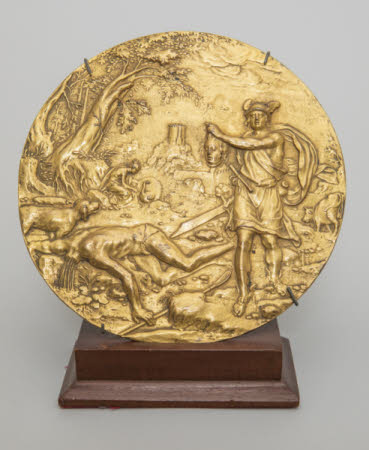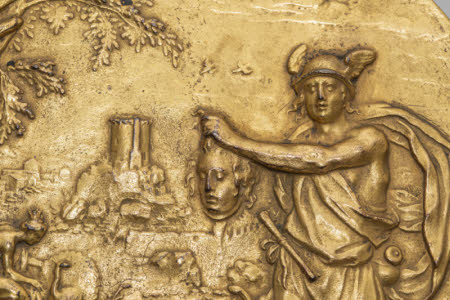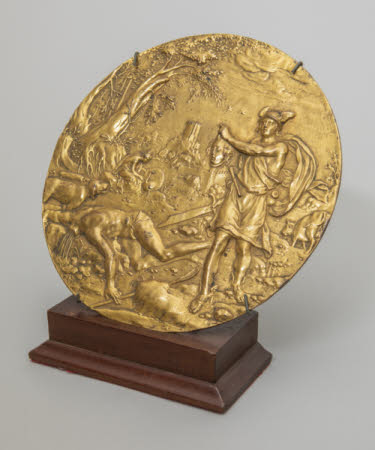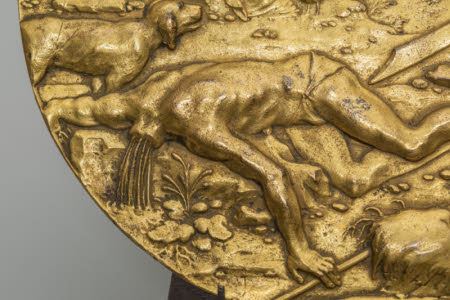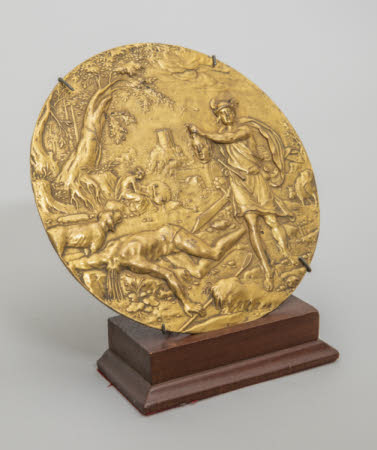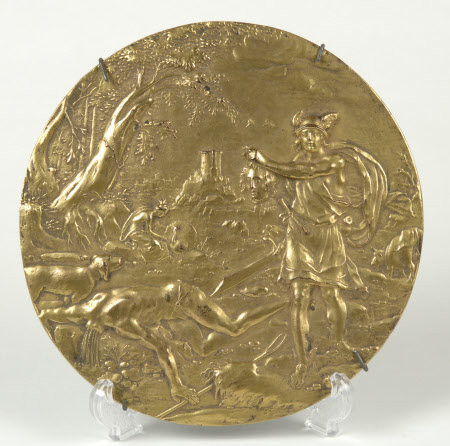Mercury with the head of Argus
workshop of Paulus Willemsz van Vianen (Utrecht c.1570 - Prague 1613)
Category
Art / Sculpture
Date
c. 1600 - 1620
Materials
Gilt bronze
Measurements
196 mm (7 ¾ in) Diameter
Place of origin
Prague
Order this imageCollection
Kingston Lacy Estate, Dorset
NT 1255222.4
Summary
Sculpture, gilt-bronze; Mercury and the dead Argus; Paulus van Vianen (c. 1570-1613) and workshop; c. 1606-1620. One of a set of four gilt-bronze roundels featuring scenes from the Roman poet Ovid’s Metamorphoses, designed by the Utrecht-born silversmith Paulus van Vianen. Part of a series of at least twelve designs, which would have been used in objects made from silver such as shallow dishes (tazze), but were also reproduced in bronze and in lead. The four plaquettes now at Kingston Lacy possibly come from the large group of these designs recorded in the collection of King Charles I, in his Cabinet at Whitehall Palace in 1638 or 1639.
Full description
A gilded bronze roundel depicting Mercury with the dead Argus. Mercury at right strides towards the viewer, dressed in tunic and cloak and wearing his winged helmet and sandals. At his waist is the pipe Mercury had used to send Argus to sleep, whilst he also wears at his waist a water bottle, referring to his role as the god of travellers. In Mercury’s right hand is a sword whilst in his left hand he holds, by its hair, the decapitated head of Argus. Argus’s body lies at left, blood streaming from his neck, his herdsman's staff beneath his left hand. His dog stands beside him, howling disconsolately. A cow, representing Io, at far right. In the middle distance left of centre is seated the goddess Juno, who caresses her peacock and adds Argus’s eyes to its tail. Large tree and woody landscape left. In the distance a city. The front surface is entirely gilded. Part of a series of four similar reliefs (1255222.1-4). This relief, and its companion featuring Mercury being sent by Jupiter to kill Argus, recount parts of the story of Jupiter’s transformation of Io, daughter of the King of Argos (Ovid’s Metamorphoses (I.587-747). They are part of a series of four plaquettes with scenes from this story. One of many young women whom he seduced, Jupiter transformed Io into a white heifer, in order to conceal her from the jealousy of his wife Juno. In the first relief in Paulus van Vianen’s sequence, Jupiter has just transformed Io into the heifer, whilst Juno in her chariot in the clouds looks down angrily. Well aware of the real identity of the beautiful cow, she compelled her husband to present the animal to her, giving it to her servant Argus to guard. Argus was a giant known in Greek as ‘Panoptes’ (‘all-seeing’), said to have one hundred eyes, so able to keep a constant watch in every direction. Jupiter’s response was to send the god Mercury to earth to despatch Argus (see 1255222.2). Having eventually succeeded in sending the watchful Argus to sleep by telling the story of Pan and Syrinx and piping a melody to him, as seen in the third relief, Mercury then decapitated Argus, being depicted in the final scene walking off with the severed head. Juno took the giant’s hundred eyes, setting them into the tail of her peacock as a memorial to her faithful watchman (some versions of the story also suggest that Argus was transformed into a peacock). With his death, Io was nevertheless liberated. She henceforth wandered the earth as a cow, although she is said to have been constantly tormented by a gadfly sent by Juno. The four reliefs are a faithful telling of the story of Io. The one major deviation is the depiction, with understandable artistic licence, of Argus not as a many-eyed monstrous giant, but as a lithe young man. The learned audiences for whom Paulus van Vianen made these reliefs would also have spotted the prominent role that he gives in these reliefs to Argus’s dog, seen howling in the horrific final plaque. Argus was the name of the faithful dog of Ulysses (Odysseus), the only creature to recognise its master when he finally returned to Ithaca from the Trojan war. The four gilt-bronze circular reliefs at Kingston Lacy all illustrate episodes from the Roman poet Ovid’s long poem ‘Metamorphoses’, which became a very popular source for artists, composers and writers from the Renaissance period onwards. All the stories in the Metamorphoses concern transformations of gods and other individuals in mythology. The set at Kingston Lacy is just part of a larger series of at least twelve large circular plaques with episodes from the Metamorphoses. The larger series included four scenes from the story of Jupiter, Juno and Io (including 1255222.2 and 4) and another four from the story of the sun god Phoebus and the death of his son Phaethon. Finally, two scenes from the story of Jupiter, Juno and Callisto survive, as well as the two from the story of Apollo, Cupid and the nymph Daphne (see 1255222.1 and 3). It is possible that other lost scenes from these stories once existed. For discussion of the series and the attribution to Paulus van Vianen, see NT 1255222.1. All the plaquettes are extremely rare, most surviving in just one or two examples in bronze or in lead, and a couple only known through documentary references. The only other known surviving version of the scwene of Mercury cutting off the head of Argus is the lead cast in the Ashmolean Museum, Oxford. Also in the Ashmolean is a rectangular bronze relief showing just the figure of Mercury, and Io as a heifer at right; a second oval version was sold at auction from the Alain Edrei collection in April 2023 (Morton and Eden, London, 20th April 2023, lot 198). Another cast of the whole scene, formerly in the Kunstgewerbemuseum in Berlin, was lost during the Second World War. A silver copy made c. 1624 and marked with the signature of an unknown silversmith ‘HL’, was formerly on the Amsterdam art market (Frederiks 1952, no. 100). It is one of three inferior copies by HL after scenes in the story of Io. The design was also re-used, with the other three from the story of Io, on a large dish in the Frisian Museum, Leeuwarden (Frederiks 1952, no. 183) by Rintie Jans (fl. 1646 – after 1673). It is also to be found, together with the scene of Mercury piping Argus to sleep, on the top register of an ivory drinking horn in Rosenborg castle, possibly made in Copenhagen around the 1680s (Hein 2018, no. 155). Finally, another oval plaquette featuring just the figure of Argus is in the British Museum, London (Warren 2014, III, p. 1013, fig. 383). Jeremy Warren May 2023
Provenance
First recorded In the 1860 inventory drawn up by Rosa Louisa Bankes (1827-1878); by descent; bequeathed by (Henry John) Ralph Bankes (1902-1981), together with the estates of Corfe Castle and Kingston Lacy and its entire contents
Makers and roles
workshop of Paulus Willemsz van Vianen (Utrecht c.1570 - Prague 1613) , sculptor after Paulus Willemsz van Vianen (Utrecht c.1570 - Prague 1613) , original artist
References
Frederiks 1952: J.W. Frederiks, Dutch Silver. I. Embossed Plaquettes, Tazze and Dishes from the Renaissance until the end of the eighteenth century, The Hague 1952, no.83 Z. Weber 1975: Ingrid Weber, Deutsche, Niederländische und Französische Renaissanceplaketten 1500-1650, 2 vols., Munich 1975, no.948.4, Taf. 267. Ter Molen 1984: J.R. ter Molen, ‚Van Vianen: een Utrechtse familie van zilversmeden met een internationale faam‘, PhD Dissertation, 2 vols., Leiderdorp 1984, no.130. Warren 2014: Jeremy Warren, Medieval and Renaissance Sculpture in the Ashmolean Museum, 3 vols., Oxford 2014, nos. 479-80. Hein 2018: Jørgen Hein, Ivories and Narwhal Tusks at Rosenborg Castle: Catalogue of Carved and Turned Ivories and Narwhal Tusks in the Royal Danish Collection 1600–1875, 2 vols., Copenhagen 2018, I, pp. 244-48, no. 155.
